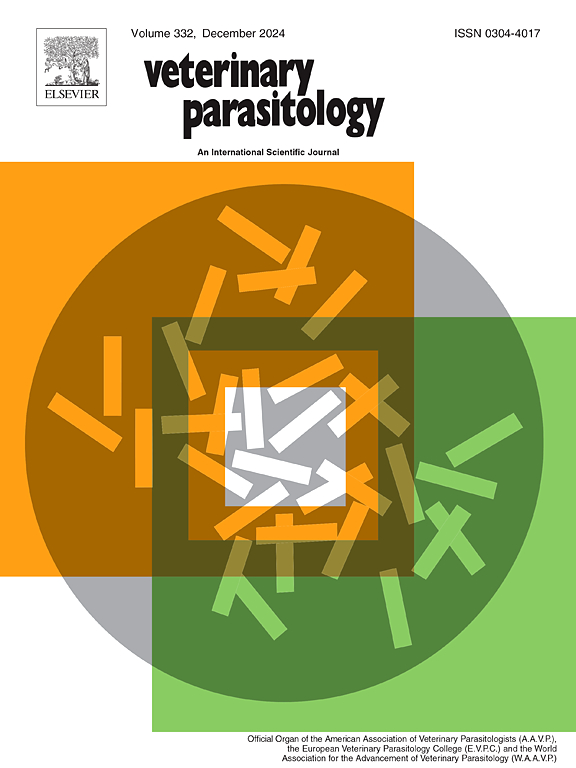An RPA-CRISPR/Cas12a-assisted method for nucleic acid detection of Haemonchus contortus in sheep
IF 2
2区 农林科学
Q2 PARASITOLOGY
引用次数: 0
Abstract
Haemonchus contortus (H. contortus), a highly pathogenic and blood-feeding nematode, could cause haemonchosis,resulting in tens of billions of dollars in production losses and significantly impacting the development of sheep husbandry. Rapid and accurate detection methods were particularly important for the prevention and control of haemonchosis. In this study, we developed a one-pot effective detection method that integrating recombinase polymerase amplification (RPA) with CRISPR/Cas12a technology based on the conserved region of ITS2 of H. contortus, with readout through fluorescence signals visualized by lateral flow strips (LFS) and observable under UV or blue light. The detection procedure was successfully finished in within 1 h and demonstrated high specificity and sensitivity, with no cross-reactivity detected with nine other common ovine pathogens and a detection limit as low as 0.1 copies/μL for fluorescence and 100 copies/μL for LFS. Validation with 89 sheep fecal samples revealed a 46.07 % positivity rate, fully consistent with quantitative PCR results. In summary, the RPA-CRISPR/Cas12a method for H. contortus detection exhibited the advantages of high specificity, high sensitivity, and low device dependence, portable and visible results. The technique presented significant potential for large-scale clinical application and provided novel point-of-care testing for clinical use in remote rural and resource-constrained areas.
一种RPA-CRISPR/ cas12a辅助的绵羊弯曲血蜱核酸检测方法
弯曲血孔虫(Haemonchus contortus, H. contortus)是一种高致病性的吸血线虫,可引起血液病,造成数百亿美元的生产损失,并严重影响绵羊畜牧业的发展。快速准确的检测方法对于预防和控制血友病尤为重要。在本研究中,我们基于H. contortus ITS2的保守区,开发了一种将重组酶聚合酶扩增(RPA)与CRISPR/Cas12a技术相结合的一锅有效检测方法,通过荧光信号通过横向流条带(LFS)显示,在紫外或蓝光下可观察到。该方法在1 h内完成检测,具有较高的特异性和灵敏度,与其他9种常见羊病原菌无交叉反应,荧光检测限低至0.1 copies/μL, LFS检测限低至100 copies/μL。89份羊粪便样品验证,阳性率46.07 %,与定量PCR结果完全一致。综上所述,RPA-CRISPR/Cas12a方法检测H. contortus具有特异性高、灵敏度高、设备依赖性低、便携、结果可见等优点。该技术具有大规模临床应用的巨大潜力,并为偏远农村和资源受限地区的临床使用提供了新的护理点测试。
本文章由计算机程序翻译,如有差异,请以英文原文为准。
求助全文
约1分钟内获得全文
求助全文
来源期刊

Veterinary parasitology
农林科学-寄生虫学
CiteScore
5.30
自引率
7.70%
发文量
126
审稿时长
36 days
期刊介绍:
The journal Veterinary Parasitology has an open access mirror journal,Veterinary Parasitology: X, sharing the same aims and scope, editorial team, submission system and rigorous peer review.
This journal is concerned with those aspects of helminthology, protozoology and entomology which are of interest to animal health investigators, veterinary practitioners and others with a special interest in parasitology. Papers of the highest quality dealing with all aspects of disease prevention, pathology, treatment, epidemiology, and control of parasites in all domesticated animals, fall within the scope of the journal. Papers of geographically limited (local) interest which are not of interest to an international audience will not be accepted. Authors who submit papers based on local data will need to indicate why their paper is relevant to a broader readership.
Parasitological studies on laboratory animals fall within the scope of the journal only if they provide a reasonably close model of a disease of domestic animals. Additionally the journal will consider papers relating to wildlife species where they may act as disease reservoirs to domestic animals, or as a zoonotic reservoir. Case studies considered to be unique or of specific interest to the journal, will also be considered on occasions at the Editors'' discretion. Papers dealing exclusively with the taxonomy of parasites do not fall within the scope of the journal.
 求助内容:
求助内容: 应助结果提醒方式:
应助结果提醒方式:


